Bangkok to Saigon Cycle Challenge 2003
Traffic and Roads
Traffic
We could describe traffic in the cities as "organised chaos". While
Saigon has traffic lights and street signs (which are observed) and thus
creates a semblance of order, there is no such thing in Cambodia. The
traffic just flows. People simply wait for a gap and then move. Since
there are always a lot of people moving at once, this opens up a gap for
others and thus creates a similar effect as achieved by traffic lights,
only more efficiently. Of course, it helps that almost all traffic is
two-wheeled. My estimate is that the throughput (in the number of
people) of a road in Cambodia is at least ten times that of a road of
similar width in Sydney. I wish the RTA would even start to understand this...
The important point about participating in this traffic is to go with
the flow, never against it. To cross a road one looks for a gap and starts
walking. Not too fast, not too slow, but most of all, keep
walking and do not stop or back-track once you have stepped onto
the road. Keep an eye on the on-coming traffic, but just do not stop and
stand still. Essentially, the traffic will move around you as long as
they can read from your unwavering path which direction you intend to
go. If you stop or reverse you're likely to cause an accident.
Transport
 In the Cambodian countryside
carts pulled by a small motorcycle seem to be the equivalent of local
busses. People use them to get to work or markets when the
distances are too far for walking or cycling.
In the Cambodian countryside
carts pulled by a small motorcycle seem to be the equivalent of local
busses. People use them to get to work or markets when the
distances are too far for walking or cycling.
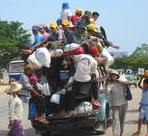 For longer distances (between towns)
incredibly overloaded pickups are used, with meal service at every
stop ;-) This is obviously what we had been offered when people at
the Thai/Cambodian border were trying to sell us pick-up rides to Siem
Reap. We'd prefer the comfort and safety of a mountain bike any day...
For longer distances (between towns)
incredibly overloaded pickups are used, with meal service at every
stop ;-) This is obviously what we had been offered when people at
the Thai/Cambodian border were trying to sell us pick-up rides to Siem
Reap. We'd prefer the comfort and safety of a mountain bike any day...

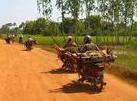 It is, however, impressive what is being transported by two-wheeled
vehicles. Three fully-grown pigs on
a single motorcycle? No problem. The poor animals aren't all that
happy, as one can imagine (rough roads and 30+°C). At every stop
they get hosed down, but the RSPCA would have a field day.
It is, however, impressive what is being transported by two-wheeled
vehicles. Three fully-grown pigs on
a single motorcycle? No problem. The poor animals aren't all that
happy, as one can imagine (rough roads and 30+°C). At every stop
they get hosed down, but the RSPCA would have a field day.
 Or a basket that carries easily 20 piglets, stuffed in there without much space to move
when the basket is full. Or a two-metre-high
load of baskets.
Or a basket that carries easily 20 piglets, stuffed in there without much space to move
when the basket is full. Or a two-metre-high
load of baskets.
 On small country roads we also encounter more traditional ways of
transporting goods like oxcarts transporting pottery. This was in the
area between Kampong Chhnang and Phnom Penh, which is know for its
pottery. There, you'll find pots everywhere and of every size, from a
few centimetres to a good
metre in size.
On small country roads we also encounter more traditional ways of
transporting goods like oxcarts transporting pottery. This was in the
area between Kampong Chhnang and Phnom Penh, which is know for its
pottery. There, you'll find pots everywhere and of every size, from a
few centimetres to a good
metre in size.


 However, the primary means of transport in Cambodia is clearly the
bicycle, which is part of the attraction of bicycle touring in this
area. Bicycles are simply everywhere. Children ride to school in long processions. Small kids ride with
their even smaller siblings
on the back. More than once we saw a family of five on a single bicycle
(unfortunately we haven't got a photo of that). And at every school
there are hundreds of
bicycles densely but neatly parked.
However, the primary means of transport in Cambodia is clearly the
bicycle, which is part of the attraction of bicycle touring in this
area. Bicycles are simply everywhere. Children ride to school in long processions. Small kids ride with
their even smaller siblings
on the back. More than once we saw a family of five on a single bicycle
(unfortunately we haven't got a photo of that). And at every school
there are hundreds of
bicycles densely but neatly parked.
 A slightly more unusual sight is the lady
riding her tri-cycle, pushed not by foot pedals but by a hand
crank. We had actually been told to expect see such vehicles for
disabled people (mostly war veterans and civilian victims of land
mines) much more frequently, but this was the only time apart from a
few cases in the border town to Thailand. It seems that the visible
signs of many years of war are slowly vanishing.
A slightly more unusual sight is the lady
riding her tri-cycle, pushed not by foot pedals but by a hand
crank. We had actually been told to expect see such vehicles for
disabled people (mostly war veterans and civilian victims of land
mines) much more frequently, but this was the only time apart from a
few cases in the border town to Thailand. It seems that the visible
signs of many years of war are slowly vanishing.
One interesting observation about the difference between Cambodia and
Vietnam is that in the former country, between a quarter and half of the
motorcyclists wear helmets, in Saigon hardly anyone. Needless to say, only
tourists wear helmets on a bicycle (but we also tend to ride faster than
the locals ;-)
Roads
Thailand
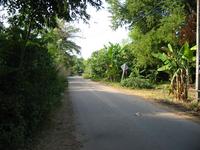 The roads in Thailand are mostly in good shape. Major roads tend to have
fairly heavy traffic, including lots of heavy trucks, so it is best to
stay away from them. Instead, Tanin took us through small country roads,
which lead through many small villages tucked away between some big, shady
trees.
The roads in Thailand are mostly in good shape. Major roads tend to have
fairly heavy traffic, including lots of heavy trucks, so it is best to
stay away from them. Instead, Tanin took us through small country roads,
which lead through many small villages tucked away between some big, shady
trees.

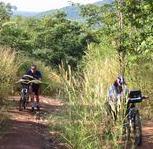 In Khao Khiaw National Park we are riding on some nice MTB tracks through beautiful
scenery, although parts of them are just
a tad too steep for us...
In Khao Khiaw National Park we are riding on some nice MTB tracks through beautiful
scenery, although parts of them are just
a tad too steep for us...
Cambodia
Cambodia is fun for cycling not only because there being so many
other cyclists, but also because the roads are great fun (on a good
mountain bike at least).
 The first stretch in Cambodia, Route No.5 from the Thai border to Sisophon (and on
to Battambang, Kompong Chhnang and Phnom Penh), is in "good"
condition. What this means is that the road is mostly smooth blacktop
with frequent potholes, often several metres across and half a metre
deep, where traffic slaloms around them. At times, the street narrows
to a small dirt road with single-threaded traffic.
The first stretch in Cambodia, Route No.5 from the Thai border to Sisophon (and on
to Battambang, Kompong Chhnang and Phnom Penh), is in "good"
condition. What this means is that the road is mostly smooth blacktop
with frequent potholes, often several metres across and half a metre
deep, where traffic slaloms around them. At times, the street narrows
to a small dirt road with single-threaded traffic.
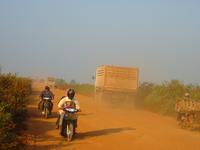 From Sisophon we are on the only slightly less busy
Route No.6, which is the eastern
route to Phnom Penh, via Siem Reap and around the east side of Lake
Tonlé Sap. Here we understand why the previous road, Route 5,
was called a "good road".
From Sisophon we are on the only slightly less busy
Route No.6, which is the eastern
route to Phnom Penh, via Siem Reap and around the east side of Lake
Tonlé Sap. Here we understand why the previous road, Route 5,
was called a "good road".
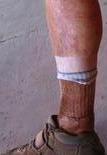
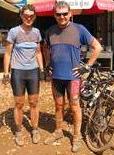 We are going relatively slow, a leisurely 20km/h,
and stay mostly close together. The riding is in most parts actually not
very difficult, as there tends to be a narrow (~20cm wide) sandy strip
which forms a relatively
flat "lane" at the edge of the road, and where all the cyclists
ride. The cars are, in fact, not much faster than us, we estimate they
average 30-40km/h. Reggie, due to an inflamed knee and hip, has to pause and
ride in the bus for half a day. Her comment: "travelling in the bus
sucks!", and that didn't just relate to missing out on the riding—we
can see the vehicles swaying left and right as they negotiate the
road.
We are going relatively slow, a leisurely 20km/h,
and stay mostly close together. The riding is in most parts actually not
very difficult, as there tends to be a narrow (~20cm wide) sandy strip
which forms a relatively
flat "lane" at the edge of the road, and where all the cyclists
ride. The cars are, in fact, not much faster than us, we estimate they
average 30-40km/h. Reggie, due to an inflamed knee and hip, has to pause and
ride in the bus for half a day. Her comment: "travelling in the bus
sucks!", and that didn't just relate to missing out on the riding—we
can see the vehicles swaying left and right as they negotiate the
road.
The dust is actually normally not very dense, and we give up soon on
riding with a face mask (which had been recommended to us)—it's more
of a nuisance than a help. However, over 80km we collect a lot of dust
all over us, mostly on the legs, of course. We haven't felt so dirty in a long time!
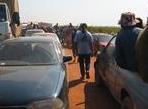


 About halfway to Siem Reap, we are treated to a
special event: a damaged bridge. It is only passable in single file, and
that only slowly. Of course, there is a big traffic jam on either side,
and total chaos. And naturally, this offers a business opportunity
too—people are selling fruit and drinks. It takes even us
several minutes to make it through the mess, and we worried how long
our support vehicle, a van, might be held up. Fortunately it catches
up with us within an hour.
About halfway to Siem Reap, we are treated to a
special event: a damaged bridge. It is only passable in single file, and
that only slowly. Of course, there is a big traffic jam on either side,
and total chaos. And naturally, this offers a business opportunity
too—people are selling fruit and drinks. It takes even us
several minutes to make it through the mess, and we worried how long
our support vehicle, a van, might be held up. Fortunately it catches
up with us within an hour.
Siem Reap to Phnom Penh
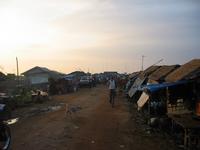
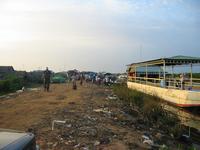 Quite adventurous is also the road leading from Siem Riep to the speed boat landing area on Lake
Tonlé Sap: narrow, unsealed, full of potholes, and garbage everywhere.
Quite adventurous is also the road leading from Siem Riep to the speed boat landing area on Lake
Tonlé Sap: narrow, unsealed, full of potholes, and garbage everywhere.
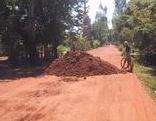 We have been riding on a number of other dirt roads, mostly around Kampong
Chhnang and between the town of Udong and Phnom Penh. Most of them are
in very reasonable shape, although one is never safe from surprises,
such as when a big pile of
dirt suddenly blocked the road. Not much of a challenge for the
bicycles, but certainly for the bus.
We have been riding on a number of other dirt roads, mostly around Kampong
Chhnang and between the town of Udong and Phnom Penh. Most of them are
in very reasonable shape, although one is never safe from surprises,
such as when a big pile of
dirt suddenly blocked the road. Not much of a challenge for the
bicycles, but certainly for the bus.
 From Phnom Penh to the Vietnamese border we follow Route No.1. Out of Phnom
Penh it follows the west bank of the Mekong. It is mostly good blacktop,
but ever so often there are some nice potholes too. Nothing to slow us down, and
there is usually plenty of space to sway around. Very pleasant riding
in fact. (The potholes are slightly more of a challenge for cars or
buses.) It is pretty much all the same for the 65km until the ferry across the Mekong.
From Phnom Penh to the Vietnamese border we follow Route No.1. Out of Phnom
Penh it follows the west bank of the Mekong. It is mostly good blacktop,
but ever so often there are some nice potholes too. Nothing to slow us down, and
there is usually plenty of space to sway around. Very pleasant riding
in fact. (The potholes are slightly more of a challenge for cars or
buses.) It is pretty much all the same for the 65km until the ferry across the Mekong.
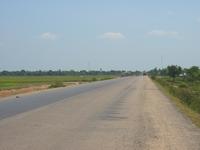 From there the road heads East for another 60km to Svay Rieng. This road
is all new, in excellent condition, probably built during the previous
dry season. Must be a dream for Cambodian motorists, for us it's a
torture. The surface is quite rough (meaning increased rolling
resistance) and, unlike most roads we had been on, it is not lined with any trees. This not only
means full exposure to any wind (and we had a slight head wind) but also
to the sun. This is one of the tougher bits of riding, and it's
certainly the least fun. Consequently, Symbiosis has now changed the
route; from 2004 on, the BSCC stayed south of Route No.1.
From there the road heads East for another 60km to Svay Rieng. This road
is all new, in excellent condition, probably built during the previous
dry season. Must be a dream for Cambodian motorists, for us it's a
torture. The surface is quite rough (meaning increased rolling
resistance) and, unlike most roads we had been on, it is not lined with any trees. This not only
means full exposure to any wind (and we had a slight head wind) but also
to the sun. This is one of the tougher bits of riding, and it's
certainly the least fun. Consequently, Symbiosis has now changed the
route; from 2004 on, the BSCC stayed south of Route No.1.
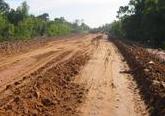
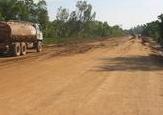
 The last 20-25km to the border are again great
fun. The road is being re-done, and at the time we go through it
alternates between reasonably good, firm dirt surface and a very soft
surface that isn't trivial to ride as it is, but would turn into deep
mud in rain.
The last 20-25km to the border are again great
fun. The road is being re-done, and at the time we go through it
alternates between reasonably good, firm dirt surface and a very soft
surface that isn't trivial to ride as it is, but would turn into deep
mud in rain.
Vietnam

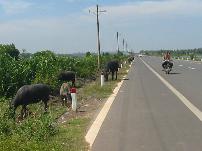 The difference between Cambodia and Vietnam couldn't be more dramatic
as where we crossed the border (although, next season, with the construction
of Cambodian Route No.1 completed, it will be much less impressive).
The roads in Vietnam would put to shame almost everything NSW has to offer.
Perfectly smooth surface, marked lanes, and an almost 2m wide lane for bicycles and slow vehicles. The
buffaloes grazing at the side are
the strongest reminder that we are still in South East Asia.
The difference between Cambodia and Vietnam couldn't be more dramatic
as where we crossed the border (although, next season, with the construction
of Cambodian Route No.1 completed, it will be much less impressive).
The roads in Vietnam would put to shame almost everything NSW has to offer.
Perfectly smooth surface, marked lanes, and an almost 2m wide lane for bicycles and slow vehicles. The
buffaloes grazing at the side are
the strongest reminder that we are still in South East Asia.
Waterways
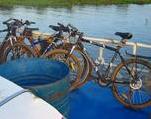

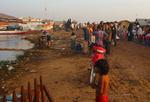 The speed boats across Lake Tonlé Sap and further down the
Stung Tonlé Sap River to Phnom Penh are a modern, slick
affair. The boat landing is reached via some poor stretch of
road. Boarding is via a small wooden plank. We then have to carry the
bicycles on a narrow walkway to the back of the boat, where they were
safely tied down. We have to carry everything with us, since we leave
the van and support team behind and will meet a fresh team at the other
end of the lake (except that Dara accompanies us to the handover).
The speed boats across Lake Tonlé Sap and further down the
Stung Tonlé Sap River to Phnom Penh are a modern, slick
affair. The boat landing is reached via some poor stretch of
road. Boarding is via a small wooden plank. We then have to carry the
bicycles on a narrow walkway to the back of the boat, where they were
safely tied down. We have to carry everything with us, since we leave
the van and support team behind and will meet a fresh team at the other
end of the lake (except that Dara accompanies us to the handover).
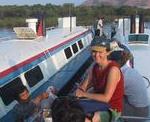
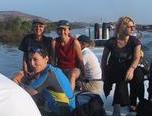
 The majority of passengers are tourists. We suspect that
the ride is a fair bit more expensive than the (longer, much slower and
less comfortable) ride on the road by bus or pickup.
The majority of passengers are tourists. We suspect that
the ride is a fair bit more expensive than the (longer, much slower and
less comfortable) ride on the road by bus or pickup.
The ride itself is fairly uneventful. Once past the house boats in
the mouth of the "litter river", we reach the open lake and see nothing
but water and sky for about two hours. After about 100km of lake we see
the shore again, and the boat continues at a much slower pace for
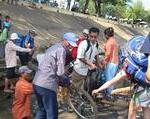
 another hour the 40-45km until we reach Kompong Chhnang. There it
doesn't actually dock, it just stops in the middle of the river. We
unload everything onto a small barge, which then gets us to shore, where
we unload everything with the help of some keen volunteers. In
hindsight, the whole transaction was not without a challenge,
considering that we had to carry all our luggage and our bicycle across
the narrow outside walkway of the speed boat, and then drop everything
onto the barge in the middle of the river.
another hour the 40-45km until we reach Kompong Chhnang. There it
doesn't actually dock, it just stops in the middle of the river. We
unload everything onto a small barge, which then gets us to shore, where
we unload everything with the help of some keen volunteers. In
hindsight, the whole transaction was not without a challenge,
considering that we had to carry all our luggage and our bicycle across
the narrow outside walkway of the speed boat, and then drop everything
onto the barge in the middle of the river.
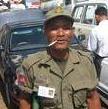
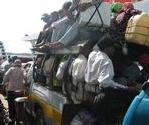

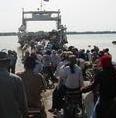 The Mekong ferry is again a truly Asian experience. Lots of
passengers and heavily loaded vehicles get off and on, bicycles are
actually in the minority here. The people don't even get off the
incredibly loaded pickups, the patience of the locals is amazing.
The Mekong ferry is again a truly Asian experience. Lots of
passengers and heavily loaded vehicles get off and on, bicycles are
actually in the minority here. The people don't even get off the
incredibly loaded pickups, the patience of the locals is amazing.

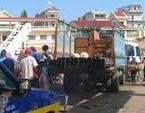 In the middle of the river we pass the ferry going the other way, so
we can see how we look from a distance ;-) A few minutes later we
disembark again in Meak Luong, in front of a backdrop of colonial
architecture.
In the middle of the river we pass the ferry going the other way, so
we can see how we look from a distance ;-) A few minutes later we
disembark again in Meak Luong, in front of a backdrop of colonial
architecture.
Return to main page of
Bangkok to Saigon Cycle Challenge 2003
© Gernot Heiser 2003.
 In the Cambodian countryside
carts pulled by a small motorcycle seem to be the equivalent of local
busses. People use them to get to work or markets when the
distances are too far for walking or cycling.
In the Cambodian countryside
carts pulled by a small motorcycle seem to be the equivalent of local
busses. People use them to get to work or markets when the
distances are too far for walking or cycling.
 For longer distances (between towns)
incredibly overloaded pickups are used, with meal service at every
stop ;-) This is obviously what we had been offered when people at
the Thai/Cambodian border were trying to sell us pick-up rides to Siem
Reap. We'd prefer the comfort and safety of a mountain bike any day...
For longer distances (between towns)
incredibly overloaded pickups are used, with meal service at every
stop ;-) This is obviously what we had been offered when people at
the Thai/Cambodian border were trying to sell us pick-up rides to Siem
Reap. We'd prefer the comfort and safety of a mountain bike any day...









































